
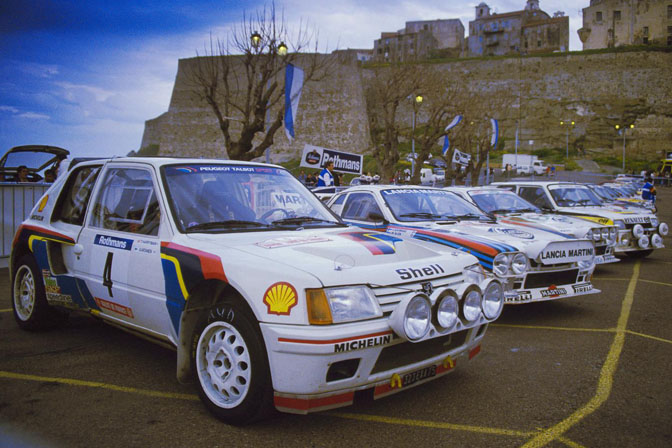
We round off this AWD month on Speedhunters with a look back to the golden age of Rallying, Group B.
A time when rally cars were true supercars. Four wheel drive, over 500bhp, mid-engine layouts, space-frame chassis and massive budgets. It is remembered as the golden era of Rallying, but it would only last a few years.
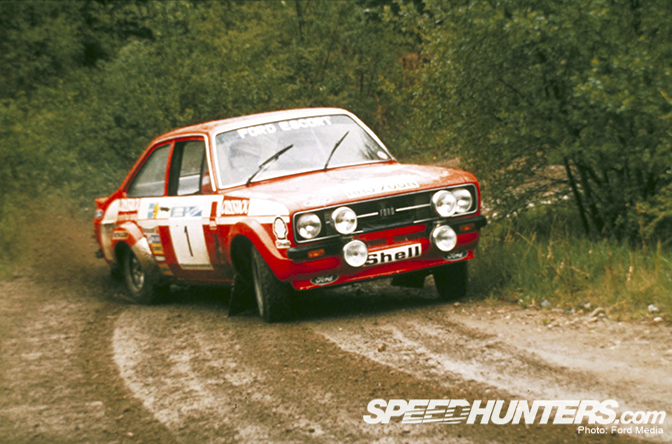
Rallying in the 1970’s was all about the domination of Ford Escort. One of the most successful rally cars of all time. It won multiple national and international championships and is still used in National Rallies today. The Fiat 131 Abarth, Lancia Stratos, Opel Ascona 400 and Renault 5 Turbo were competition for the mighty Escort.
At least, it was, until the end of the decade. FISA, the governing body, allowed all-wheel-drive for rallying for the first time. Initially, it was seen as an irrelevant change. Many Manufactures believed the weight penalty would outweigh the benefits and little changed.
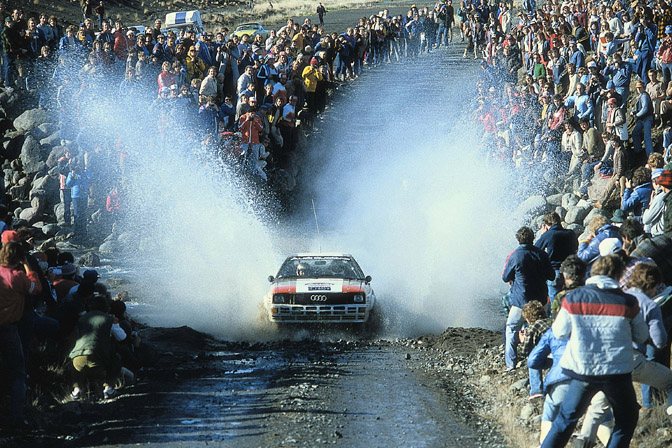
Audi saw things a little different. They were already developing the Quattro system, so the new rules were a perfect platform to promote the new Audi Quattro. By the end of the first competitive rally, everyone else knew they had to play catch up…. fast.
While Audi continued to win Rallies, FISA introduced new rules in 1982. Group B, A and N replaced the old class structure (Group 2 and 4). The most significant change was the reduction in production numbers from 400 to just 200 to meet homologation for Group B. . Evolution versions could also be produced once 20 chassis has been built.
Suddenly, making rally specials was more achievable. Group 4 cars were still eligable under Group B rules, so it allowed a greater variety of cars.
Lets take a look at a selection of successful Group B rally cars…
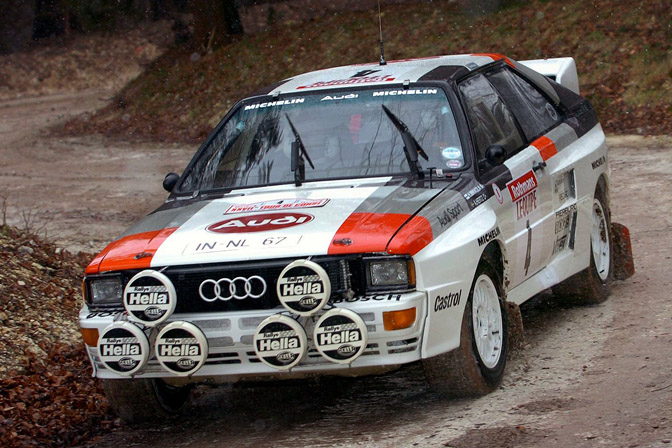
AUDI
The original Audi Quattro ran to the older Group 4 specification was dominant, taking the 1982 Manufacturers title. However, Audi faced tough competition the following year with the introduction of the Lancia 037. Audi’s Hannu Mikkola won the drivers championship, but the manufacture title would end up in Italian hands.
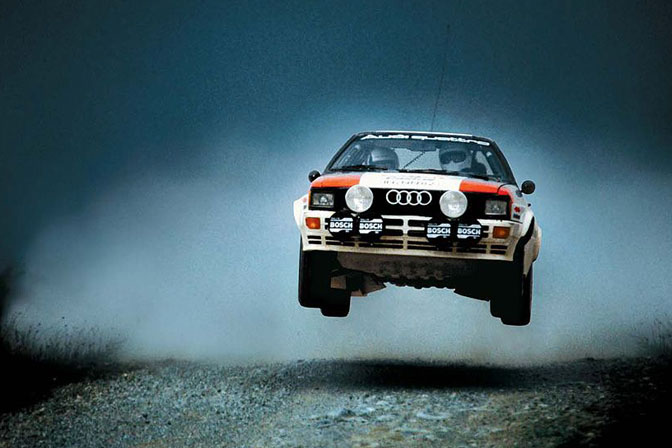
Behind the scenes, Audi was developing the first Group B specification, the Quattro ‘A1′ Evolution, introduced in early 1983.
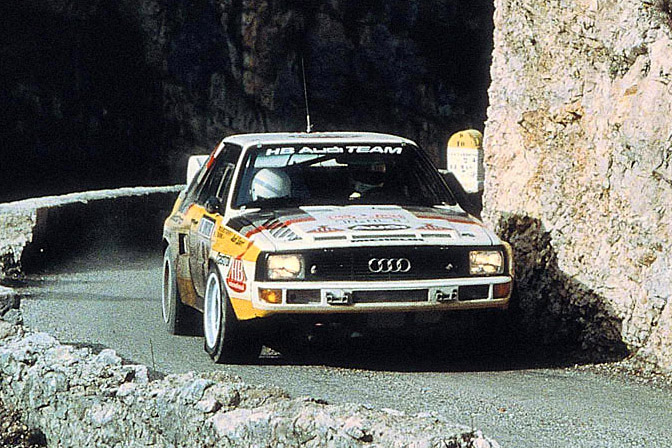
Audi realised this was only a stop gap with such open rules and set to work on a new Quattro variant, the 450bhp ‘Sport Quattro’ which made its debut in 1984.
Visually, the car had a shorter wheelbase and a more upright windscreen (from the Audi 80). This latest development helped Audi to retake the Manufacture crown, with Audi driver, Stig Blomqvist as Drivers Champion.
Such was the pace of development that the Sport Quattro was obsolete in 1985, thanks to the new standards set by the Peugeot 205 Turbo 16 and Lancia S4 mid-engined rally cars.
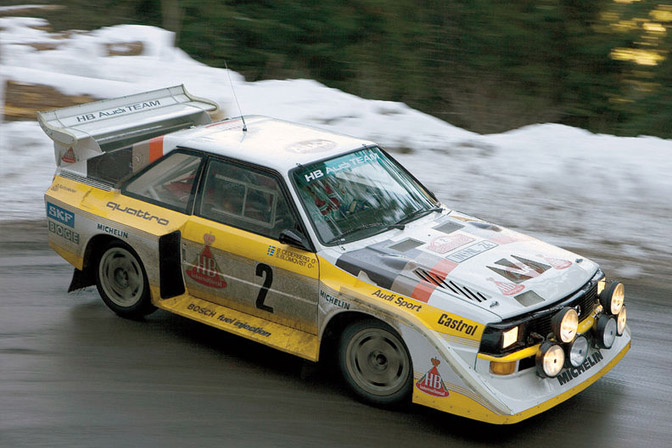
Audi continued to to develop the Quattro and the wild ‘S1′ made its debut at the 1000 Lakes rally in 1985. Extreme wide body kit and wings were required to harness the 600bhp beast. Despite the looks it was too little too late, the front engine placement put Audi at a disadvantage and it didn’t handle as well as the mid-engine machines. The S1 won just once in 1985.
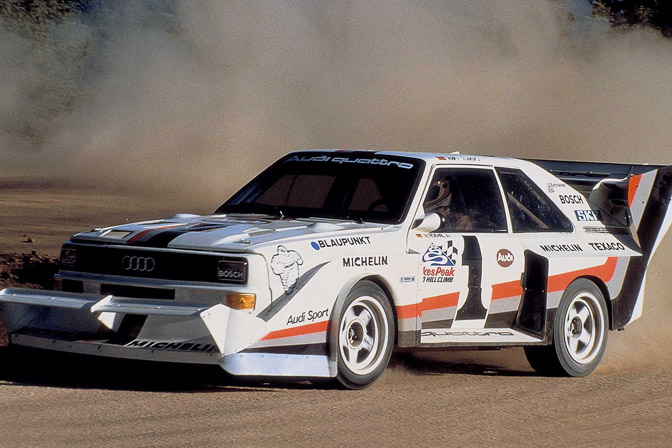
Audi’s Group B programme was cancelled in 1986 following the death of Henri Toivonen on the Tour de Course. The Sport Quattro would live on at Pike Peaks and would help launch the Quattro range to the public.
You can read more about the story of the Audi Quattro in our car feature .
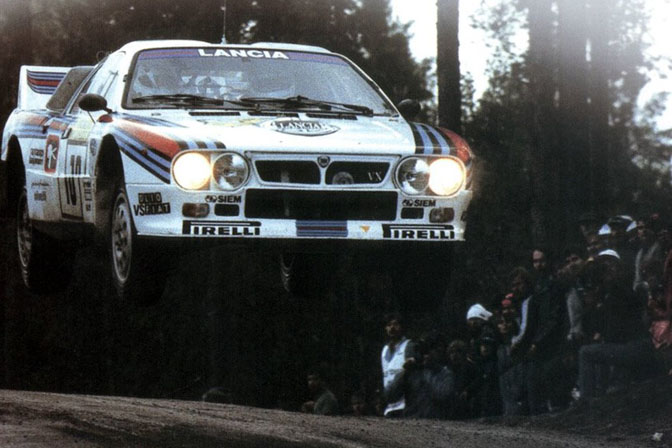
LANCIA
The very first Group B car was the Lancia 037 Rally car. This was loosely based on the Lancia Beta Montecarlo, but under the skin, it was very different. Mid-engine 2Litre Supercharged unit pumping out about 280bhp. Although it didn’t have four wheel drive, Lancia won the 1983 Manufactures title, in the hands of Water Rohrl and Markku Alen, largely down to better reliability than Audi.
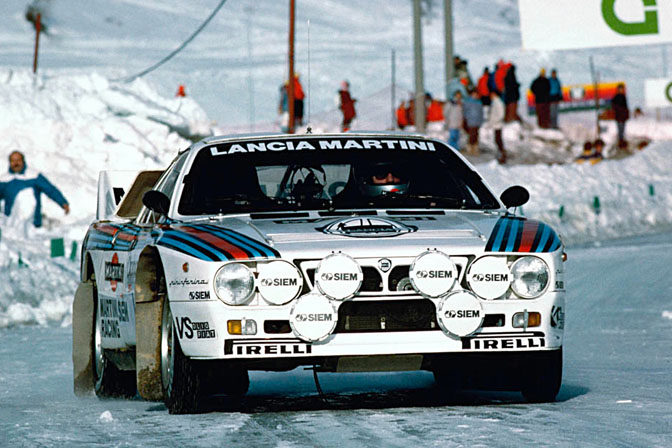
Almost immediately, the Lancia was rendered obsolete when Peugeot introduced their 205 Turbo 16 rally car and Audi, the ‘Sport Quattro’.
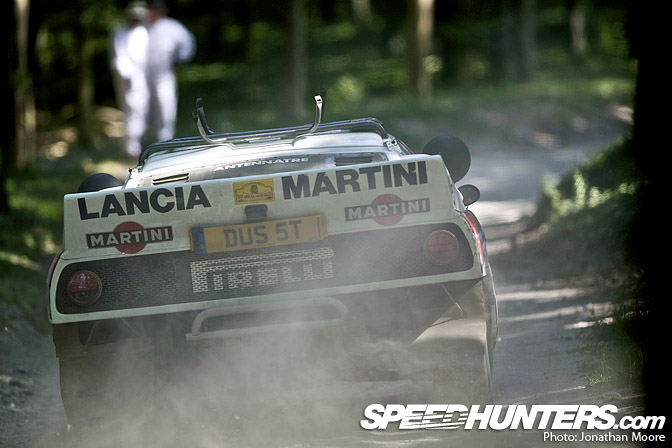
In the space of a few months, a front runner was now just an also-ran.
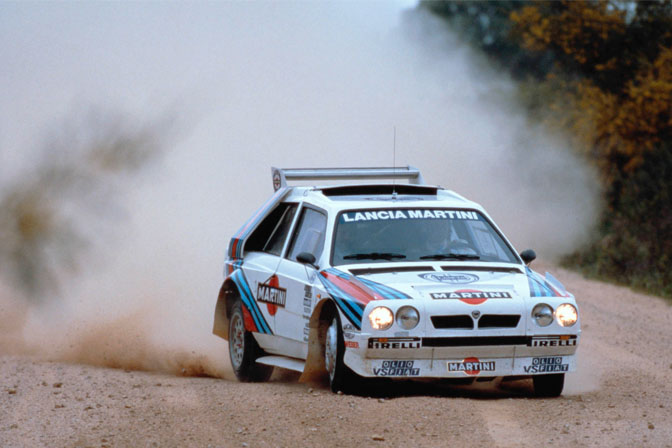
Lancia introduced the ‘Delta S4’ in late 1985. It shared nothing with the normal ‘shopping’ Lancia Delta. The S4 moved the goalposts on, with a turbo AND a supercharger. The Supercharger worked at lower revs and the Turbo kicked in at higher revs. Lancia achieved a 1-2 on its first rally, the 1985 RAC Rally with Henri Toivonen.
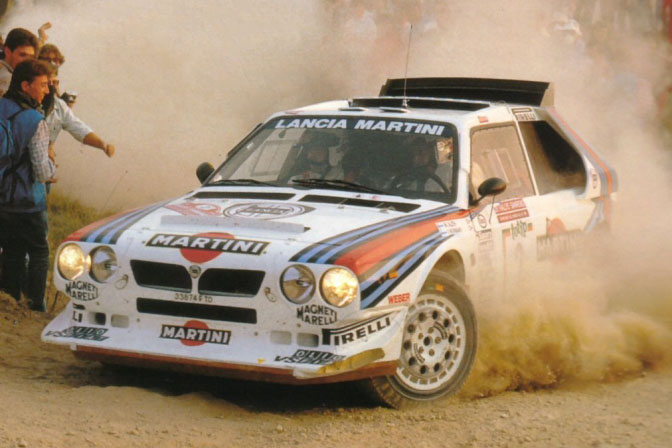
1986 started off well, but the Tour de Corse as a very dark period for Rallying.
Henri Toivonen and co-driver Sergio Cresto died after plunging into a ravine in there Lancia S4. It is unclear what happened, but the car was engulfed in flames and by the time rescuers reached the wreck, it as a charred mess. This contributed to the cancellation of Group B.
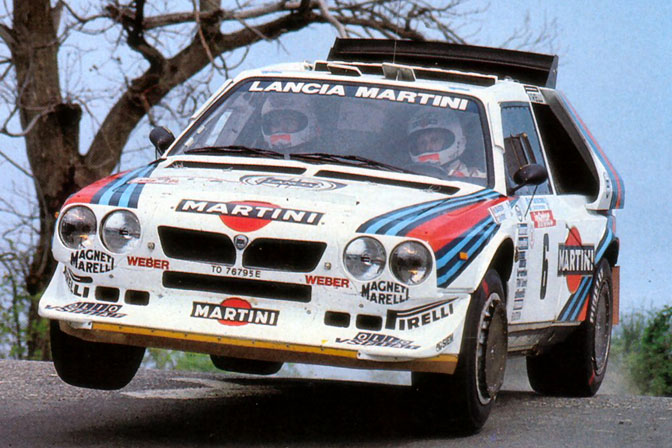
Toivonen’s team mate, Markku Alen was initially the 1986 Drivers Champion until the FIA annulled the San Remo Rally results due to technical irregularities, handing the title to Peugeot’s Juha Kankkunen
Lancia would continue in Group A in the late eighties with the successful Lancia Delta Integrale.
PEUGEOT
The Peugeot 205 Turbo 16, introduced in 1984, was one of the most significant cars to be introduced. Based loosely on the 205 GTi supermini silhouette, this Group B machine was mid-engined spaceframed chassis and shared very few parts with its road going counterpart.
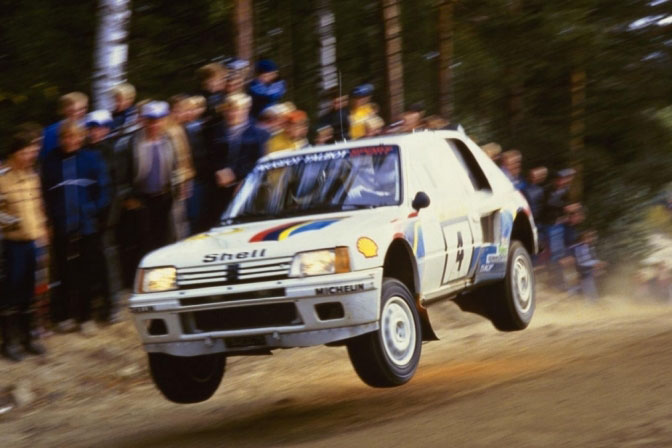
Lead by Jean Todt, the T16 was immediately on the pace with Ari Vatanen as lead driver. As I write this, Todt and Vatanen are going against each other in the FIA elections to replace Mad Max Mosley. How times change.
The 205 was immediately quick and won on its 3rd outing on the 1984 1000 Lakes Rally. Peugeot carried this momentum into 1985 winning the championship with Timo Salonen as well as the all important manufacture crown. Ari Vatanen was very lucky to survive one of the biggest rally accidents at the time in Agentina. The car rolled multiple times during which Ari’s seat broke. Ari was unable to compete again for over a year.
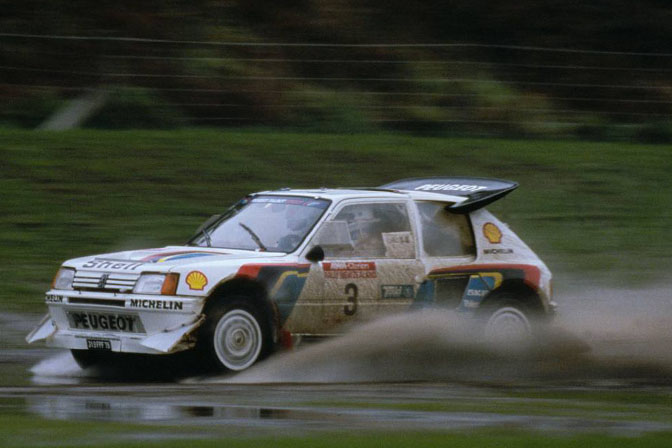
With Peugeot under pressure from Lancia and Audi, the French team introduced the ‘Evolution2’ model for 1986. The car sported new aerodynamics with a deeper front bumper, canards and huge rear wing.
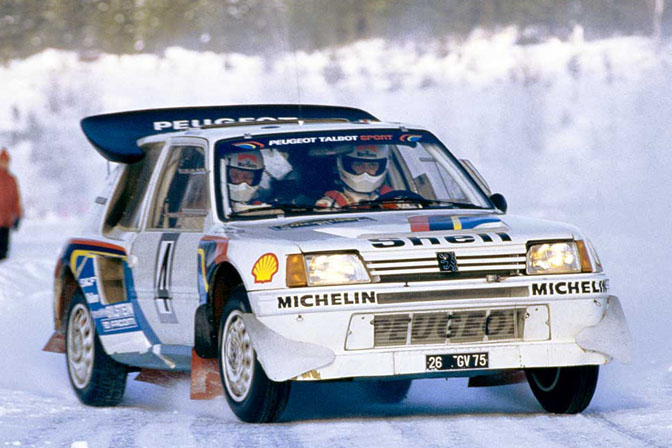
Although Ford and Audi pulled out following Toivonen’s death, Peugeot continued and were crowned the 1986 Manufactures Drivers Championship with Juha Kankkunen. Note the thin snow tyres above, from the Swedish Rally.
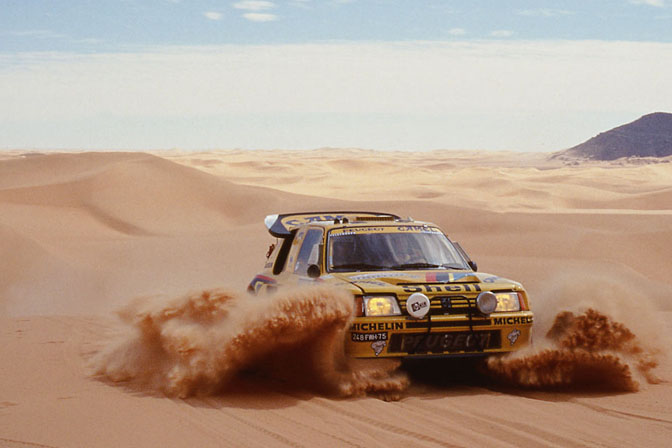
With Group B cancelled, the 205T16 would continue in the Paris Dakar Rally and be used as a base for the new Peugeot 405 T16 ‘Raid’ car which would later set the overall record at Pikes Peaks with Ari Vatanen.
FORD
Ford were late to Group B. Having rested on their laurels with the Escort Mk2, Ford started development on the Escort RS1700T relatively late, using the 3rd Generation European Ford Escort.
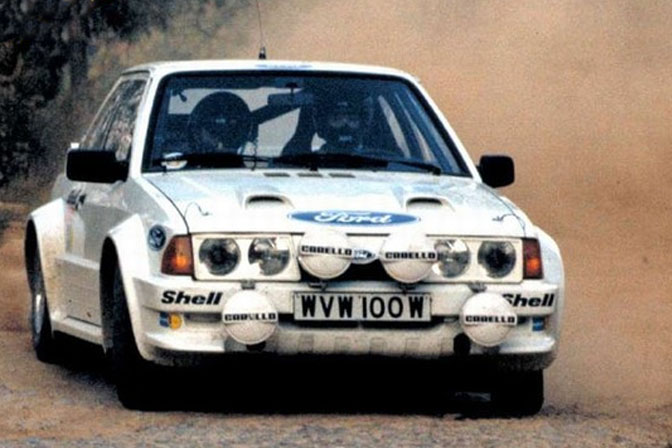
The car was uncompetitive and the project cancelled very early on. Ford realized a radical approach would be required if they were to be competitive.
The Ford RS200 was a unique car, not tied to any other in the Ford range. This was very much a rally car first and road car 2nd. The car was a joint effort with Ghia Design in Italy, Ford, Bryan Hart Engines (who had experience in Formula One) and Reliant who would assist in design and build.
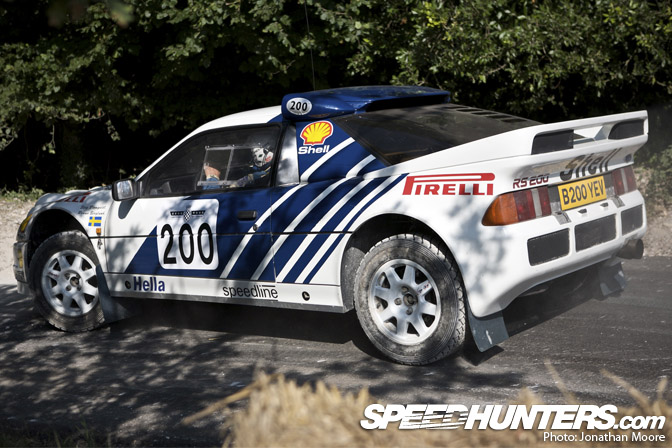
The RS200 was powered by a 1.8L 16v Turbo engine with over 500bhp. The car was very strong, but this resulted in it being overweight. It certanly looked the part.
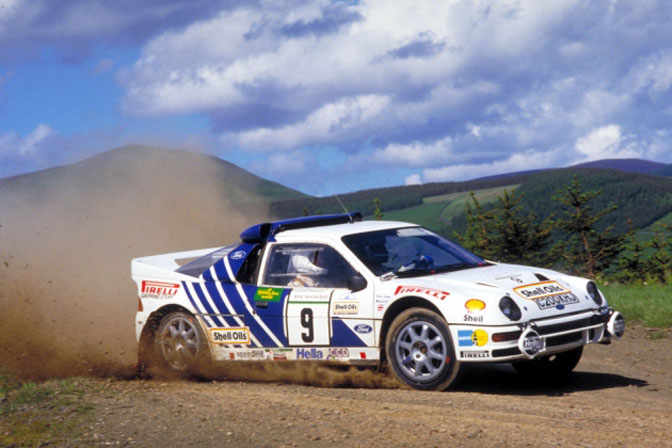
The Portuguese Rally was one of the main signals that Group B was too dangerous.Portuguese champion, Joaquim Santos came over a rise to find his path full of spectators, a common occurrence in 80’s rallying. He lost control trying to bring his RS200 to a halt and tragically 3 people were killed and 31 injured. Ford and other immediately pulled out of the event.
The next even saw the tragic death of Toivonen. Ford withdrew their RS200 from rallying even though an Evolution model was just about to be launched.
The RS200 continued with a career in Rallycross. Martin Schanche won four FIA European championships with the RS200 between 1988 and 1991. The RS200 would also be seen on the Pikes Peak Hillclimb . Mark Rennison drove a RS200 up the famous hillclimb this year, but reliability issues limited this to one run.
You can view a couple of RS200 videos we posted earlier this month here.
TOYOTA
Toyota entered the Rally championships with the Celica in 1983. Juha Kankkunen netted sixth place in an impressive performance which would see the young Fin snapped up by Peugeot the following year. Like the Ford it was very strong and reliable and it dominated the African rallies, winning the Ivory Coast and Safari Rallies during the Group B period. However, the car was more closely related to its road car relative and this compromised its performance against the might of Peugeot and Lancia.
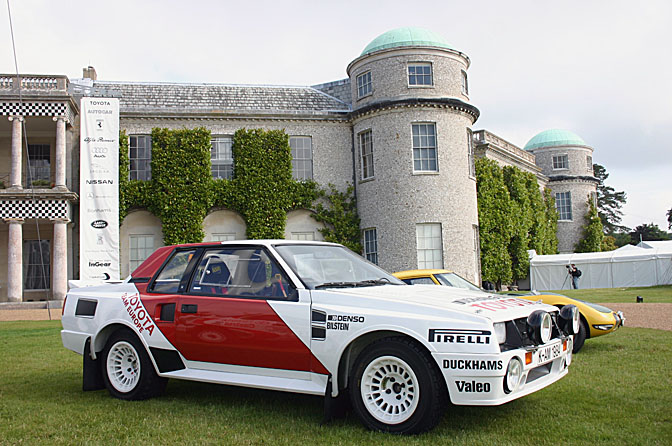
Toyota would have more success in later years with Group A Celica and Corolla rally cars.
AUSTIN ROVER
Rover wanted in on the Group B action, having has limited success with the Triumph TR7/8 and Rover SD1. Budget, as with anything associated with Rover was the biggest issue!
The MG Metro 6R4 may have looked the part with its wide bodykit, huge front and rear spoilers and rear engine cover, but the mid-engine car struggled in competition.
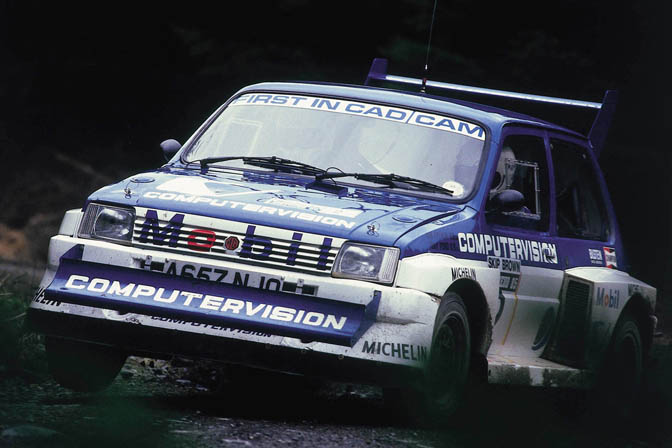
The 6R4 was developed by Williams Grand Prix Engineering and has a mid-mounted 3 Litre V6 Naturally Aspirated engine.
The life of the 6R4 was short. Introduced at the end of 1985, the team captured a well deserved podium on its International debut. Despite revised aerodynamics and cooling in 1986, the 6R4 failed to finish any of the International rallies which the works team entered. Main issues were associated with the engine or transmission. With Group B cancelled, the 6R4 was a low-cost favourite in National Rally Championships.
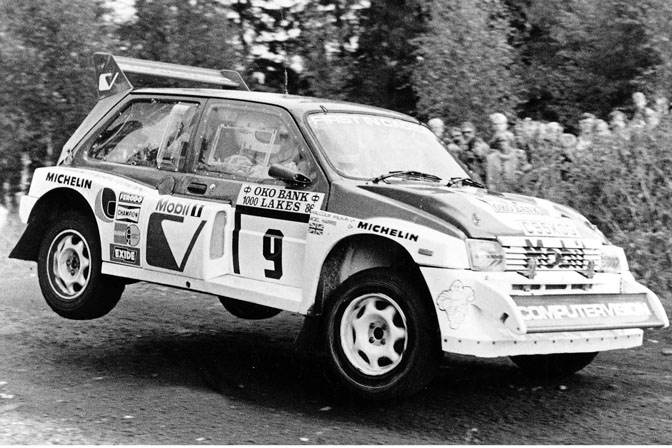
The likes of Jimmy McRae, Tony Pond, Per Eklund and Didier Auroil ran these cars with much success in National Rally Championships. 6R4’s continue to appear in British rallying today.
Remaining parts and engines were bought up by TWR and would later re-appear as the Jaguar XJ220.
There were a number of other Group B cars, but they were uncompetitive due to lack of four wheel drive, budget or development.
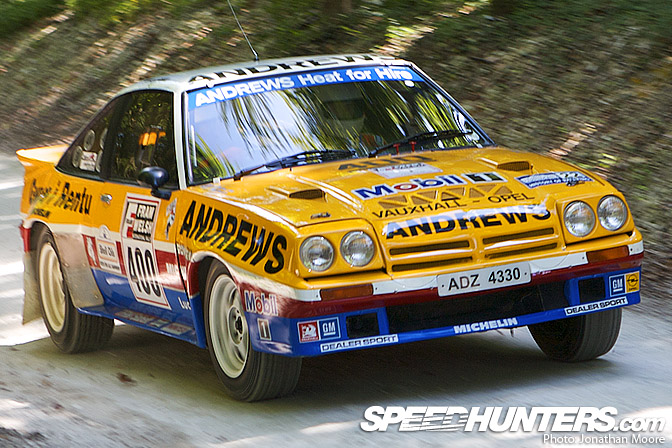
The Opel Mata 400 was a relatively successful car, even if they were closer related to their production cousins. The Manta 400 Group B car suceeded the very successful Group 4 Opel Ascona 400. Both cars were have more success in National Rally Championships. Jonathan Moore captured this Russell Brooks car at the Goodwood Festival of Speed last month. Brooks had a long career in the British championship and was always seen in the Andrews Heat for Hire livery. The Manta would not achieve the success of its predecessor.
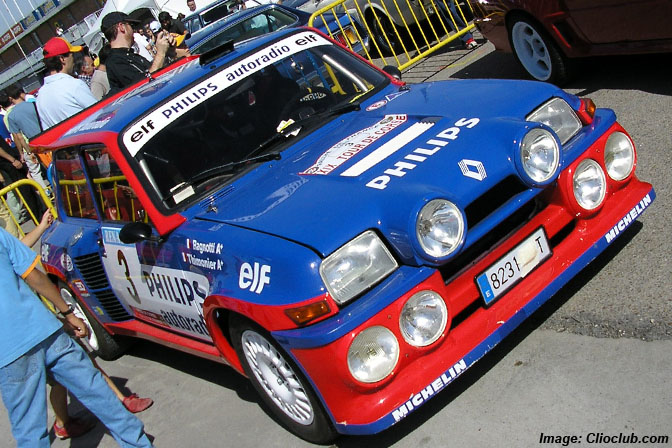
The mid-engined Renault 5 Turbo appeared back in 1980 under Group 4 regs and was competitive, winning the Monte Carlo Rally with Jean Ragnotti. A second generation ‘Maxi’ was introduced in 1984. It again won the Tour de Corse, with Ragnotti, but wasn’t really competitive with bigger budgets from Peugeot, Lancia and Renault.
This image from ClioClub.com shows Jean Ragnotti’s car in a similar spec to the final Tour de Corse win.
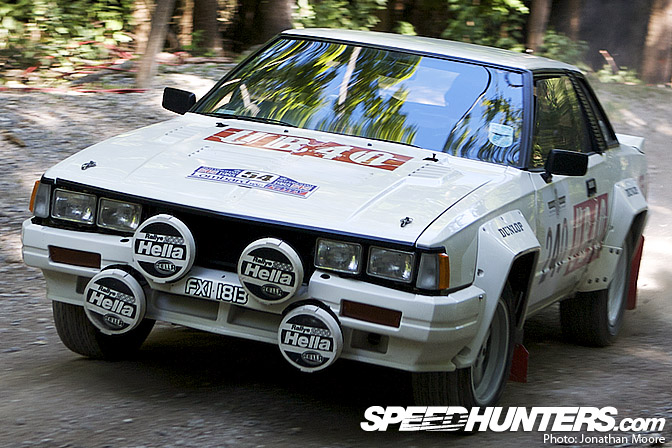
Nissan also had a presence in rallying. Success with a number of rally cars in National championships lead to the Nissan (Silvia S110) 240RS Group B car which was introduced in 1983. As the name suggests, the car was powered by a 2.4 Litre unit. Its best result was 2nd in the 1983 New Zealand Rally. The image above a UB40 sponsored Nissan 240RS at Goodwood this year.
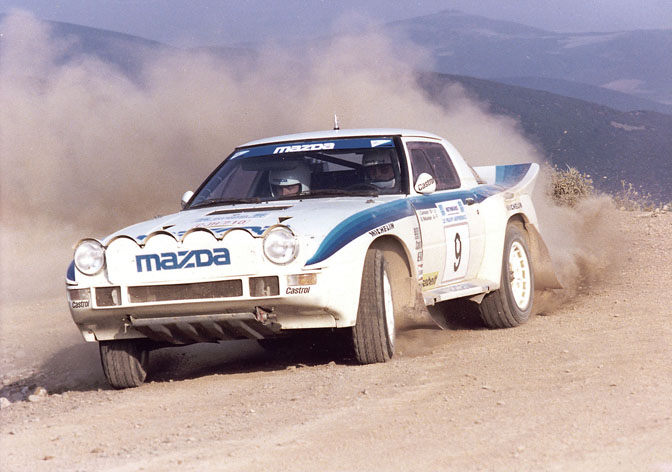
Mazda also developed a Group B RX7, but it wasn’t really competitive although it did finish 3rd in the 1985 Acropolis Rally.

Citroen was a lesson on how, not, to go Group B rallying!
Citroen had achieved resonable success with a number of Citroen Visa variants. The BX was the new mainstream model for the manufacture, so they commissioned the BX4 TC, but it was too late and by the time it appeared, Group B had moved on. The image above shows the roadcar on the right and the rally car on the left.
The 4TC took part in a couple International rallies. It was such a failure, that Citroen withdrew and was never seen again! Legend has it that Citroen scrapped as many cars as possible.
Citroen are a little bit more successful today!
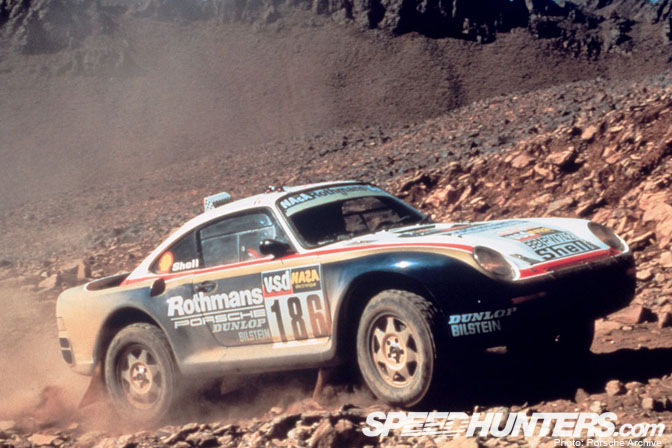
The Porsche 959 has been well documented here on Speedhunters. The 959 was designed around Group B, but by the time all 200 production cars had been produced, goals had changed and Porsche decided to show the car on the Paris Dakar rally winning the 1986 Paris Dakar and Rallye Des Pharaohs. The 959 was developed into the 961 which won its class in the Le Mans 24 Hours. It would have been really cool to have seen this on an International Rally.
You can read more about the 959 in our ‘Retrospective Feature’ back in June.
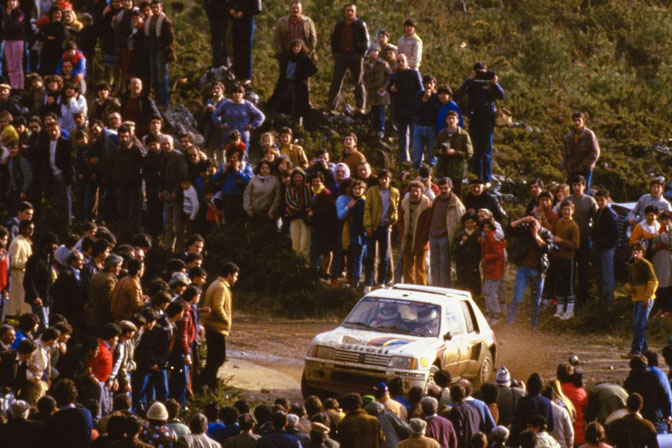
It was a golden era and as a teen living less than an hour from the Forest Of Dean and Longleat, I was very privilege to see these cars and drivers in action.
However, the cars had become too fast and dangerous too quickly. Compare the variety of cars and the crowds today with the images above and its such a shame that rallying isn’t as exciting as it once was.
Drivers Champions with Group B cars.
1984 Stig Blomqvist (Audi Quattro)
1985 Timo Salonen (Peugeot 205 Turbo 16)
1986 Juha Kankkunen (Peugeot 205 Turbo 16)
Manufacturers Champion with Group B cars.
1983 Lancia
1984 Audi
1985 Peugeot
1986 Peugeot
Andy Blackmore
Photos: Various Manufacturers, John Brooks, Jonathan Moore, ClioClub.com
Speedhunter’s Audi Quattro Retrospective.
Speedhunter’s Porsche 959 Retrospective






Awesome i enjoyed this very much great post
Wow, epic post about an epic era ! Thank's. I wish I was born a few years earlier :/
Too bad it was canceled before Toyota released his MR2 :/
http://www.groupbrally.com/toyota.shtml
aww no starions?
Very nice article
I absolutely love group B cars, such a shame that they got too dangerous, And the spectators were crazy bakc then (type "Walter Rohl oonboard, group B" at youtube - it's an onboard video from the rally of portugal)
Can we have the 3rd picture (audi with spectators and the water splash) as a desktop?
Great story about a great era of racing. It is a testament to the quality of competition that so few years of group B made such a lasting impression. It was that magical combination of almost open rules, big budgets and the dawning of a new technology (AWD) and refinement of another...forced induction.
Yossarian - Its a photo from Audi. We only release desktops of our own images. I've seen this as a wallpaper before, so have a search online.
John - No, The only 'proper' Starion Group B never competed in any events, just tested. The car before was a Group 4 car I believe (at least thats is what the reserach suggested)
Realy to sad to see what rally used to be. Not the two make crap of no with only citroen and ford. And the are gonna ban turbo and 4wd from 2010!
Lancia + Martini = <3 Interesting how an Italian car was more reliable than a German one And the "flying buttresses" on the S4 seem to be the inspiration for the ones on Bertone/Jason Castriota's Mantide concept. I can't help but imagine what might have been with the RS200, 959, and upcoming Ferrari Group B effort!
And the "flying buttresses" on the S4 seem to be the inspiration for the ones on Bertone/Jason Castriota's Mantide concept. I can't help but imagine what might have been with the RS200, 959, and upcoming Ferrari Group B effort!
I think I just died from that shot of the Audi in mid air..... fdahsjkfhioauhnjlasnfkljahkl
That was a seriously epic article.
Really enjoyed this article. It was before my time, but it's a very inspiring era of racing!
thanks Andy!
This and the Quattro article you linked in the article are fantastic. Thanks Andy and thanks Speedhunters. Brilliant!
What about the datsun stanza!! It had some serious fun in the otago rally...:D
The Stanza/Violet was another Japanese rally car which were more suited to long distance African Rallies. However, IIRC this was before Group B, tail end of the 70's

Pleased you like the article(s). It takes quite a bit of time to research them (so much confusion info on the net), but it all comes good in the end....I think
Loved the article! Man I wish Rally was more popular!
Thanks a lot for this hommage!
 )
)
Specialy for Peeugeot 205 T16 and Renaukt 5 Turbo :p
A nostalgical frenchie....
(205 rules!
wow, never knew citroen stuck in the rx, too bad it was scrapped (supposedly)...
Great post and enjoyed it alot . Would be good to do a feature on one rally car a month and get some in depth info on them . Such a great era that will always be held as the greatest time in rallying . Thanks again for a great post and keep up the good work .
wow...what a great post!...and what about group b skoda lr?
http://www.skodamotorsport.com/2005-9.jpg
http://www.skodamotorsport.com/2005-10.jpg
Nice rims on that Skoda.
"Legend has it that Citroen scrapped as many cars as possible"

It's not a legent